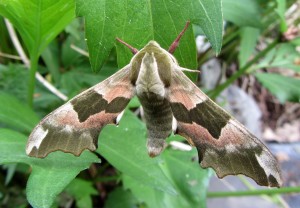Continuing the overhaul of our campus species lists, moths are the next group to have received a thorough treatment. More than 2400 species of moth have been recorded in the UK, so the current total of 113 for Whiteknights campus represents only 5% of the national fauna. However, the bulk of these records date back no further than last year’s Bioblitz, and the majority are from a single light-trapping location. It’s therefore fair to say that our list represents a decent start and covers a spectacular diversity of species. A quick flick through the image gallery should certainly be enough to dispel any notion that moths are all small, brown and boring.
Light trapping remains the best way to uncover the presence of moths at a site, and indeed is the survey method for one of the world’s longest running ecological data sets, the Rothamstead Insect Survey. Possibly of even greater importance is that it is great fun, too, a kind of year-round natural historian’s Christmas. At least, I’m sure I’m not the only one to approach a moth trap with something close to childlike anticipation. The School of Biological Sciences has a number of traps that may be available to borrow on request, the largest of which, a Robinson type with super-bright MV bulb, will be running overnight at regular intervals throughout the summer. If you’d like to have a look at the catch, follow @CWACReading on Twitter to check if the trap is out, and then come and find us in room 146 in the Harborne building from 8:30am the following morning.
For people who are neither night owls nor early birds, there are also a surprising number of attractive day-flying species, such as the Burnet Companion, which has been around in good numbers on meadows during the last week. Do submit images of any day-flying moths you come across on campus to the new KiteSite app for verification: your record may very well provide a new addition to the campus list.
It’s also worth mentioning micro-moths, which comprise more than two-thirds of UK species. Many of them have well-known associations with a single host plant – most regular visitors to Whiteknights will have seen the effect of Horse Chestnut leaf miners, for example, if not the adult moth itself – but there are at least as many species for which the larval ecology is poorly understood or even completely unknown. Given the scale and floral diversity of Whiteknights, there’s surely a lot for budding lepidopterists to discover without ever setting foot outside of the university grounds.




Great blog Chris. Justin Groves added a few moth records to the campus list during his UROP placement but we are overdue for some more exhaustive recording. Even the flowering plant list, which I thought was pretty comprehensive, has gained six new campus records in the last year.